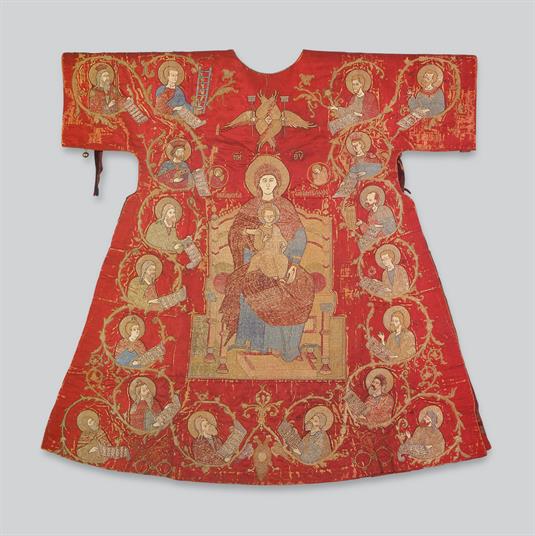Sakkos (liturgical cloth)
The sakkos is a wide tunic in the shape of a T, with short, broad sleeves. The two parts which make up the garment are sewn together at the shoulders, while the sides remain open and are tied together with cords or ribbons. The sakkos is the main priestly vestment in the Orthodox Church.
The Byzantine Museum's sakkos is made of red silk with a linen lining. It is open at the sides and joined in places with ribbons from which little bells hang down. It has images embroidered on both sides. On the front is the image of Christ the Vine: Christ, placed at the point where the criss-crossing branches of the vine meet, is blessing. On the left sleeve is depicted the angel of the Annunciation and on the right sleeve is the Virgin. On the other side the sakkos develops the iconographic subject ""The Prophets Above"". An enthroned Virgin and Child are flanked by busts of the prophets in a foliate scroll. The scene is inscribed: ΜΑΡΙΑ ΚΥΡΙΑ ΤΩΝ ΑΓΓΕΛΩΝ (Mary Our Lady of the Angels). In the lower part of the textile is a two-headed eagle, symbol of Byzantium and of the universality of the Patriarchate of Constantinople in the years after the Fall of Constantinople.
The sakkos comes from Mesembria in Eastern Romylia (now Bulgaria). It has been dated to the 17th century and it is attributed to an Epirote workshop.
- Collection: Textile
- Type: SAKKOS (LITURGICAL VESTMENT)
- Origin: Mesembria, Eastern Romylia
- Measurement: 130 x 120 cm
- Exhibit Number: ΒΧΜ 01700
- Appears in: IV.3c. Church: Place of workship/site of social cohesion

Comments
Users must be registered and logged in to comment.
No comments found.